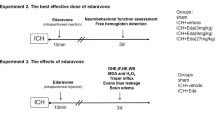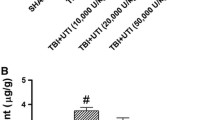Abstract
Plasmalemma permeability plays an important role in the secondary neuronal death induced by traumatic brain injury (TBI). Previous works showed that Poloxamer 188 (P188) could restore the intactness of the plasma membrane and play a cytoprotective action. However, the roles of P188 in blood–brain barrier (BBB) integrity and TBI-induced neural cell death are still not clear. In this study, mice were induced TBI by controlled cortical impact (CCI), and cerebral water content was measured to explore the profile of brain edema after CCI. Further, the regimen of P188 in mouse CCI models was optimized. The neurological test and BBB integrity assessment were performed, and the numbers of TBI-induced neural cell death were counted by propidium iodide (PI) labeling. The expression of apoptotic pathway associated proteins (Bax, cyt-c, caspase-8, caspase-9, caspase-3, P53) and aquaporin-4 (AQP4) was assessed by RT-PCR or immunoblotting. The data showed that the brain edema peaked at 24 h after TBI in untreated animals. Tail intravenous injection of P188 (4 mg/ml, 100 μl) 30 min before TBI or within 30 min after TBI could attenuate TBI-induced brain edema. P188 pre-treatment restored BBB integrity, suppressed TBI-induced neural cell death, and improved neurological function. TBI induced an up-regulation of Bax, cyt-c, caspase-8, caspase-9, caspase-3, and the expression of p53 was down-regulated by P188 pre-treatment. AQP4 mainly located on endothelial cells and astrocytes, and its expression was also regulated by P188 pretreatment. All these results revealed that P188 attenuates TBI-induced brain edema by resealing BBB and regulating AQP4 expression, and suppressed apoptosis through extrinsic or intrinsic pathway. Plasmalemma permeability may be a potential target for TBI treatment.














Similar content being viewed by others
Abbreviations
- TBI:
-
Traumatic brain injury
- P188:
-
Poloxamer 188
- PI:
-
Propidium iodide
- CCI:
-
Controlled cortical impact
- AQP4:
-
Aquaporin-4
- Bax:
-
Bcl-2 Assaciated × protein
- Caspase-3:
-
Cysteinyl aspartate-specific protease-3
- BBB:
-
Blood-brain barrier
- NVU:
-
Neurovascular unit
- ICP:
-
Intracranial pressure
- VWF:
-
Von Willebrand factor
- GFAP:
-
Glial fibrillary acidic protein
- CWC:
-
Cerebral water content
References
Plesnila N, von Baumgarten L, Retiounskaia M et al (2007) Delayed neuronal death after brain trauma involves p53-dependent inhibition of NF-kappaB transcriptional activity. Cell Death Differ 14:1529–1541
Raghupathi R (2004) Cell death mechanisms following traumatic brain injury. Brain Pathol 14:215–222
Zweckberger K, Stoffel M, Baethmann A et al (2003) Effect of decompression craniotomy on increase of contusion volume and functional outcome after controlled cortical impact in mice. J Neurotrauma 20:1307–1314
Cullen DK, Vernekar VN, LaPlaca MC (2011) Trauma-induced plasmalemma disruptions in three-dimensional neural cultures are dependent on strain modality and rate. J Neurotrauma 28:2219–2233
LaPlaca MC, Prado GR, Cullen D et al. (2009) Plasma membrane damage as a marker of neuronal injury. Conference proceedings:… Annual International Conference of the IEEE Engineering in Medicine and Biology Society. IEEE Engineering in Medicine and Biology Society. Conference, 2009:1113–1116
Pettus EH, Christman CW, Giebel ML et al (1994) Traumatically induced altered membrane permeability: its relationship to traumatically induced reactive axonal change. J Neurotrauma 11:507–522
Serbest G, Horwitz J, Barbee K (2005) The effect of poloxamer-188 on neuronal cell recovery from mechanical injury. J Neurotrauma 22:119–132
Matsumoto Y, Yamamoto S, Suzuki Y et al (2004) Na+/H+ exchanger inhibitor, SM-20220, is protective against excitotoxicity in cultured cortical neurons. Stroke 35:185–190
Unal-Cevik I, Kilinc M, Can A et al (2004) Apoptotic and necrotic death mechanisms are concomitantly activated in the same cell after cerebral ischemia. Stroke 35:2189–2194
Whalen MJ, Dalkara T, You Z et al (2008) Acute plasmalemma permeability and protracted clearance of injured cells after controlled cortical impact in mice. J Cereb Blood Flow Metab 28:490–505
Luo CL, Chen XP, Ni H et al. (2010) Comparison of labeling methods and time course of traumatic brain injury induced cell death in mice. Neural Regen Res 5:706–709
Serbest G, Horwitz J, Jost M et al (2006) Mechanisms of cell death and neuroprotection by poloxamer 188 after mechanical trauma. FASEB J 20:308–310
Greenebaum B, Blossfield K, Hannig J et al (2004) Poloxamer 188 prevents acute necrosis of adult skeletal muscle cells following high-dose irradiation. Burns 30:539–547
Baars DC, Rundell SA, Haut RC (2006) Treatment with the non-ionic surfactant poloxamer P188 reduces DNA fragmentation in cells from bovine chondral explants exposed to injurious unconfined compression. Biomech Model Mechanobiol 5:133–139
Hunter RL, Luo AZ, Zhang R et al (2010) Poloxamer 188 inhibition of ischemia/reperfusion injury: evidence for a novel anti-adhesive mechanism. Ann Clin Lab Sci 40:115–125
Yang XF, Liu WG, Shen H et al (2005) Correlation of cell apoptosis with brain edema and elevated intracranial pressure in traumatic brain injury. Chin J Traumatol 8:96–100
Shohami E, Novikov M, Mechoulam R (1993) A nonpsychotropic cannabinoid, HU-211, has cerebroprotective effects after closed head injury in the rat. J Neurotrauma 10:109–119
Bierbach B, Meier M, Kasper-Konig W et al (2008) Emboli formation rather than inflammatory mediators are responsible for increased cerebral water content after conventional and assisted beating-heart myocardial revascularization in a porcine model. Stroke 39:213–219
Robbins MA, Maksumova L, Pocock E et al (2003) Nuclear factor-kappaB translocation mediates double-stranded ribonucleic acid-induced NIT-1 beta-cell apoptosis and up-regulates caspase-12 and tumor necrosis factor receptor-associated ligand (TRAIL). Endocrinology 144:4616–4625
Feeney DM, Boyeson MG, Linn RT et al (1981) Responses to cortical injury: I. Methodology and local effects of contusions in the rat. Brain Res 211:67–77
Luo CL, Li BX, Li QQ et al (2011) Autophagy is involved in traumatic brain injury-induced cell death and contributes to functional outcome deficits in mice. Neuroscience 184:54–63
Mbye LH, Keles E, Tao L et al (2012) Kollidon VA64, a membrane-resealing agent, reduces histopathology and improves functional outcome after controlled cortical impact in mice. J Cereb Blood Flow Metab 32:515–524
Zohar O, Schreiber S, Getslev V et al (2003) Closed-head minimal traumatic brain injury produces long-term cognitive deficits in mice. Neuroscience 118:949–955
Yang B, Zador Z, Verkman AS (2008) Glial cell aquaporin-4 overexpression in transgenic mice accelerates cytotoxic brain swelling. J Biol Chem 283:15280–15286
Oliva AA Jr, Kang Y, Truettner JS et al (2011) Fluid-percussion brain injury induces changes in aquaporin channel expression. Neuroscience 180:272–279
Shaw NA (2002) The neurophysiology of concussion. Progr Neurobiol 67:281–344
Rangel-Castilla L, Gopinath S, Robertson CS (2008) Management of intracranial hypertension. Neurol Clin 26:521–541, x
Eghwrudjakpor PO, Allison AB (2010) Decompressive craniectomy following brain injury: factors important to patient outcome. Libyan J Med 5. doi:10.4176/091104
Abbott NJ (2002) Astrocyte-endothelial interactions and blood-brain barrier permeability. J Anat 200:629–638
Doelken M, Lanz S, Rennert J et al (2007) Differentiation of cytotoxic and vasogenic edema in a patient with reversible posterior leukoencephalopathy syndrome using diffusion-weighted MRI. Diagn Interv Radiol 13:125–128
Marmarou A (2003) Pathophysiology of traumatic brain edema: current concepts. Acta Neurochir 86:7–10
Donkin JJ, Vink R (2010) Mechanisms of cerebral edema in traumatic brain injury: therapeutic developments. Curr Opin Neurol 23:293–299
Lescot T, Fulla-Oller L, Palmier B et al (2010) Effect of acute poly(ADP-ribose) polymerase inhibition by 3-AB on blood-brain barrier permeability and edema formation after focal traumatic brain injury in rats. J Neurotrauma 27:1069–1079
Van Putten HP, Bouwhuis MG, Muizelaar JP et al (2005) Diffusion-weighted imaging of edema following traumatic brain injury in rats: effects of secondary hypoxia. J Neurotrauma 22:857–872
Rao KV, Reddy PV, Curtis KM et al (2011) Aquaporin-4 expression in cultured astrocytes after fluid percussion injury. J Neurotrauma 28:371–381
Lentsch AB, Ward PA (1999) Activation and regulation of NFkappaB during acute inflammation. Clin Chem Lab Med 37:205–208
Curry DJ, Wright DA, Lee RC et al (2004) Surfactant poloxamer 188-related decreases in inflammation and tissue damage after experimental brain injury in rats. J Neurosurg 101:91–96
Tomkins O, Feintuch A, Benifla M et al (2011) Blood-brain barrier breakdown following traumatic brain injury: a possible role in posttraumatic epilepsy. Cardiovasc Psychiatry Neurol 2011:765923
Shlosberg D, Benifla M, Kaufer D et al (2010) Blood-brain barrier breakdown as a therapeutic target in traumatic brain injury. Nature reviews. Neurology 6:393–403
Zhang X, Chen Y, Jenkins LW et al (2005) Bench-to-bedside review: apoptosis/programmed cell death triggered by traumatic brain injury. Crit Care 9:66–75
Verkman AS, Mitra AK (2000) Structure and function of aquaporin water channels. Am J Physiol 278:F13–F28
Marmarou A (2007) A review of progress in understanding the pathophysiology and treatment of brain edema. Neurosurg Focus 22:E1
Venero JL, Vizuete ML, Machado A et al (2001) Aquaporins in the central nervous system. Progr Neurobiol 63:321–336
Nielsen S, Nagelhus EA, Amiry-Moghaddam M et al (1997) Specialized membrane domains for water transport in glial cells: high-resolution immunogold cytochemistry of aquaporin-4 in rat brain. J Neurosci 17:171–180
Nicchia GP, Nico B, Camassa LM et al (2004) The role of aquaporin-4 in the blood-brain barrier development and integrity: studies in animal and cell culture models. Neuroscience 129:935–945
Sun MC, Honey CR, Berk C et al (2003) Regulation of aquaporin-4 in a traumatic brain injury model in rats. J Neurosurg 98:565–569
Saadoun S, Papadopoulos MC, Krishna S (2003) Water transport becomes uncoupled from K+ siphoning in brain contusion, bacterial meningitis, and brain tumours: immunohistochemical case review. J Clin Pathol 56:972–975
Ke C, Poon WS, Ng HK et al (2001) Heterogeneous responses of aquaporin-4 in oedema formation in a replicated severe traumatic brain injury model in rats. Neurosci Lett 301:21–24
Acknowledgments
The work was supported by the National Science Foundation of China (No. 81271379, No. 81172911, No. 30872666).We thank Dr. Changhong Xing who polished this paper.
Author information
Authors and Affiliations
Corresponding authors
Additional information
Hai-Jun Bao and Tao Wang contributed equally to this work.
Rights and permissions
About this article
Cite this article
Bao, HJ., Wang, T., Zhang, MY. et al. Poloxamer-188 Attenuates TBI-Induced Blood–Brain Barrier Damage Leading to Decreased Brain Edema and Reduced Cellular Death. Neurochem Res 37, 2856–2867 (2012). https://doi.org/10.1007/s11064-012-0880-4
Received:
Revised:
Accepted:
Published:
Issue Date:
DOI: https://doi.org/10.1007/s11064-012-0880-4




